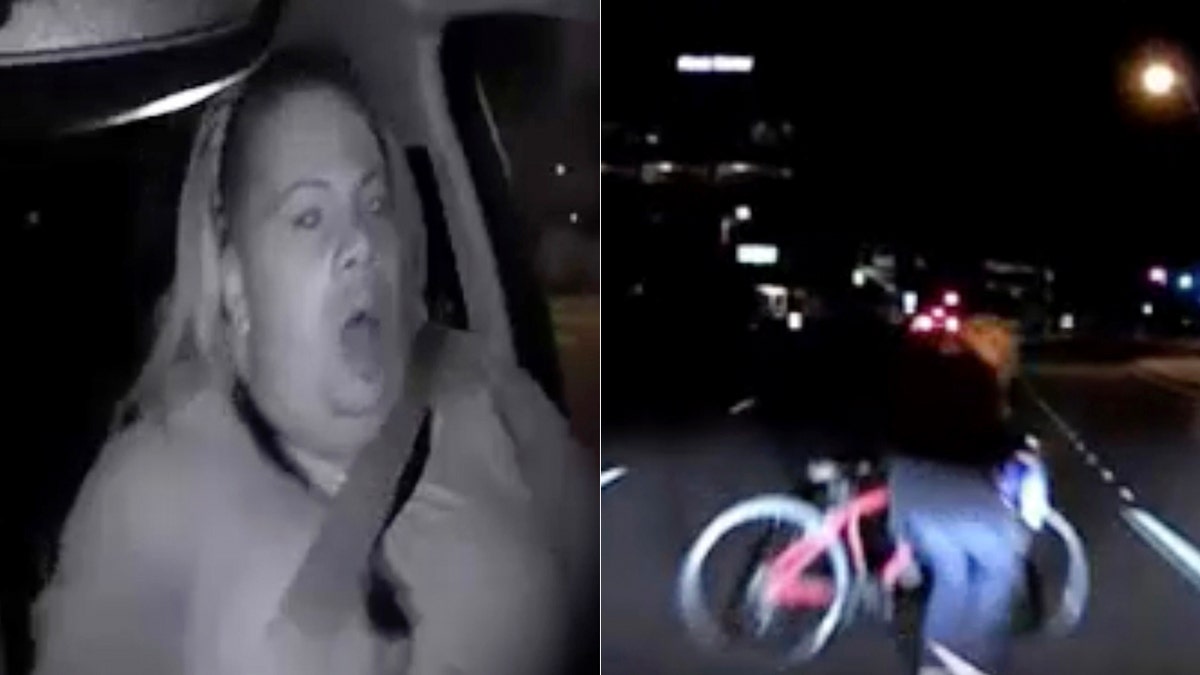Dashcam catches the moment self-driving Uber hits pedestrian
Raw video: Cameras mounted inside the car catches the fatal moment. Authorites are investigating the cause of the crash.
The first video publically released that shows the moment a self-driving Uber fatally struck a pedestrian in Tempe, Ariz., suggest that neither the SUV, nor the backup driver inside of it took evasive action to avoid the collision. Experts say that the vehicle should have.
Elaine Herzberg can be seen emerging from the darkness ahead of the Volvo XC90 equipped with Uber's self-driving technology, which includes cameras and a laser-based Lidar scanning system, as she jaywalks her bike across the road.

Rafaela Vasquez can be seen looking away from the road just before the self-driving Volvo struck 49-year-old Elaine Herzberg. (AP)
About two seconds pass before the vehicle hits Herzberg at approximately 40 mph, with no obvious signs that it applied its brakes. A shot from a camera focused on the driver shows her looking down and away from the road just before the impact, again with no clear indication that the brakes were used.
"The victim did not come out of nowhere. She's moving on a dark road, but it's an open road, so Lidar and radar should have detected and classified her" as a human, Bryant Walker Smith, a University of South Carolina law professor who studies autonomous vehicles told the Associated Press.
Smith said the video may not show the complete picture, but "this is strongly suggestive of multiple failures of Uber and its system, its automated system, and its safety driver."

Uber's self-driving vehicles are equipped with a suite of sensors designed to look for obstacles around the vehicle. (Uber)
Sam Abuelsmaid, an analyst for Navigant Research who also follows autonomous vehicles, said laser and radar systems can see in the dark much better than humans or cameras and that Herzberg was well within the range.
"It absolutely should have been able to pick her up," he said. "From what I see in the video it sure looks like the car is at fault, not the pedestrian."
Smith said that from what he observed on the video, the Uber driver appears to be relying too much on the self-driving system by not looking up at the road.
"The safety driver is clearly relying on the fact that the car is driving itself. It's the old adage that if everyone is responsible no one is responsible," Smith said. "This is everything gone wrong that these systems, if responsibly implemented, are supposed to prevent."
The experts were unsure if the test vehicle was equipped with a video monitor that the backup driver may have been viewing.
Uber immediately suspended all road-testing of such autos in the Phoenix area, Pittsburgh, San Francisco and Toronto. The National Transportation Safety Board, which makes recommendations for preventing crashes, is investigating the crash.
An Uber spokeswoman, reached Wednesday night by email, did not answer specific questions about the video or the expert observations.
"The video is disturbing and heartbreaking to watch, and our thoughts continue to be with Elaine's loved ones. Our cars remain grounded, and we're assisting local, state and federal authorities in any way we can," the company said in a statement.
Tempe police have identified the driver as 44-year-old Rafael Vasquez. Court records show someone with the same name and birthdate as Vasquez spent more than four years in prison for two felony convictions — for making false statements when obtaining unemployment benefits and attempted armed robbery — before starting work as an Uber driver.
Tempe police and the National Transportation Safety Board declined to say whether the Vasquez who was involved in the fatal crash is the same Vasquez who has two criminal convictions.
Attempts by the AP to contact Vasquez through phone numbers and social media on Wednesday afternoon weren't successful.
Local media have identified the driver as Rafaela Vasquez. Authorities would not explain the discrepancy.
The fatality has raised questions about whether Uber is doing enough to screen its drivers.
Uber said Vasquez met the company's vetting requirements.
The company bans drivers who are convicted of violent crimes or any felony within the past seven years — which Vasquez would have passed given that records show the offenses occurred in 1999 and 2000.
The company's website lists its pre-screening policies for drivers that spell out what drivers can and cannot have on their record to work for Uber.
Their driving history can't have any DUI or drug-related driving offenses within the past seven years, for instance. They also can't have more than three non-fatal accidents or moving violations within the past three years.
With the Associated Press




















